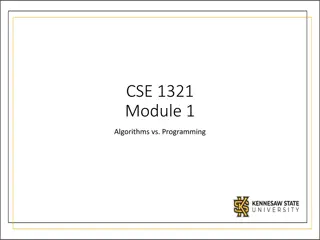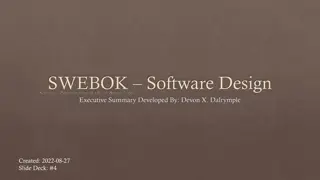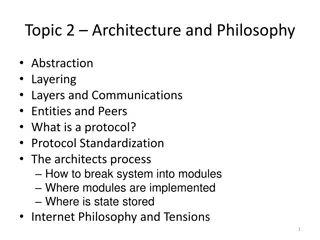Abstraction Functions in Software Design
In software design, understanding the concept of abstraction functions is crucial for implementing specifications correctly. Abstraction functions map concrete representations to abstract values, guiding developers in ensuring data structures' integrity and interpretation. This text delves into how representation invariants and abstraction functions play a pivotal role in connecting implementations to specifications, emphasizing the importance of adhering to these principles for maintaining software integrity and functionality.
Download Presentation

Please find below an Image/Link to download the presentation.
The content on the website is provided AS IS for your information and personal use only. It may not be sold, licensed, or shared on other websites without obtaining consent from the author.If you encounter any issues during the download, it is possible that the publisher has removed the file from their server.
You are allowed to download the files provided on this website for personal or commercial use, subject to the condition that they are used lawfully. All files are the property of their respective owners.
The content on the website is provided AS IS for your information and personal use only. It may not be sold, licensed, or shared on other websites without obtaining consent from the author.
E N D
Presentation Transcript
CSE 331 Software Design & Implementation Dan Grossman Fall 2014 Abstraction Functions (Based on slides by Mike Ernst, David Notkin, Hal Perkins)
Connecting implementations to specs Representation Invariant: maps Object boolean Indicates if an instance is well-formed Defines the set of valid concrete values Only values in the valid set make sense as implementations of an abstract value For implementors/debuggers/maintainers of the abstraction: no object should ever violate the rep invariant Such an object has no useful meaning Abstraction Function: maps Object abstract value What the data structure means as an abstract value How the data structure is to be interpreted Only defined on objects meeting the rep invariant For implementors/debuggers/maintainers of the abstraction: Each procedure should meet its spec (abstract values) by doing the right thing with the concrete representation CSE331 Fall 2014 2
Rep inv. constrains structure, not meaning An implementation of insert that preserves the rep invariant: public void insert(Character c) { Character cc = new Character(encrypt(c)); if (!elts.contains(cc)) elts.addElement(cc); } public boolean member(Character c) { return elts.contains(c); } Program is still wrong Clients observe incorrect behavior What client code exposes the error? Where is the error? We must consider the meaning The abstraction function helps us CSE331 Fall 2014 CharSet s = new CharSet(); s.insert('a'); if (s.member('a')) 3
Abstraction function: repabstract value Theabstraction function maps the concrete representation to the abstract value it represents AF: Object abstract value AF(CharSet this) = { c | c is contained in this.elts } set of Characters contained in this.elts Not executable because abstract values are just conceptual The abstraction function lets us reason about what [concrete] methods do in terms of the clients [abstract] view CSE331 Fall 2014 4
Abstraction function and insert Goal is to satisfy the specification of insert: // modifies: this // effects: thispost = thispre U {c} public void insert (Character c) { } The AF tells us what the rep means, which lets us place the blame AF(CharSet this) = { c | c is contained in this.elts } Consider a call to insert: On entry, meaning is AF(thispre) eltspre On exit, meaning is AF(thispost) = AF(thispre) U {encrypt('a')} What if we used this abstraction function instead? AF(this) = { c | encrypt(c) is contained in this.elts } = { decrypt(c) | c is contained in this.elts } CSE331 Fall 2014 5
The abstraction function is a function Why do we map concrete to abstract and not vice versa? It s not a function in the other direction Example: lists [a,b] and [b,a] might each represent the set {a, b} It s not as useful in the other direction Purpose is to reason about whether our methods are manipulating concrete representations correctly in terms of the abstract specifications CSE331 Fall 2014 6
Abstract stack with array and top index implementation Stack AF example new() 0 0 0 pop() 17 -9 0 Top=0 Top=1 stack = <17> stack = <> Abstract states are the same stack = <17> = <17> push(17) 17 0 0 Top=1 stack = <17> Concrete states are different <[17,0,0], top=1> <[17,-9,0], top=1> push(-9) 17 -9 0 Top=2 stack = <17,-9> AF is a function Inverse of AF is not a function CSE331 Fall 2014 7
Benevolent side effects Different implementation of member: boolean member(Character c1) { int i = elts.indexOf(c1); if (i == -1) return false; // move-to-front optimization Character c2 = elts.elementAt(0); elts.set(0, c1); elts.set(i, c2); return true; } Move-to-front speeds up repeated membership tests Mutates rep, but does not change abstract value AF maps both reps to the same abstract value Precise reasoning/explanation for clients can t tell a AF AF op r r CSE331 Fall 2014 8
For any correct operation CSE331 Fall 2014 9
Writing an abstraction function Domain: all representations that satisfy the rep invariant Range: can be tricky to denote For mathematical entities like sets: easy For more complex abstractions: give names to specification AF defines the value of each specification field Overview section of the specification should provide a notation of writing abstract values Could implement a method for printing in this notation Useful for debugging Often a good choice for toString CSE331 Fall 2014 10
Data Abstraction: Summary Rep invariant Which concrete values represent abstract values Abstraction function For each concrete value, which abstract value it represents Together, they modularize the implementation Neither one is part of the ADT s specification Both are needed to reason an implementation satisfies the specification In practice, representation invariants are documented more often and more carefully than abstraction functions A more widely understood and appreciated concept CSE331 Fall 2014 11























